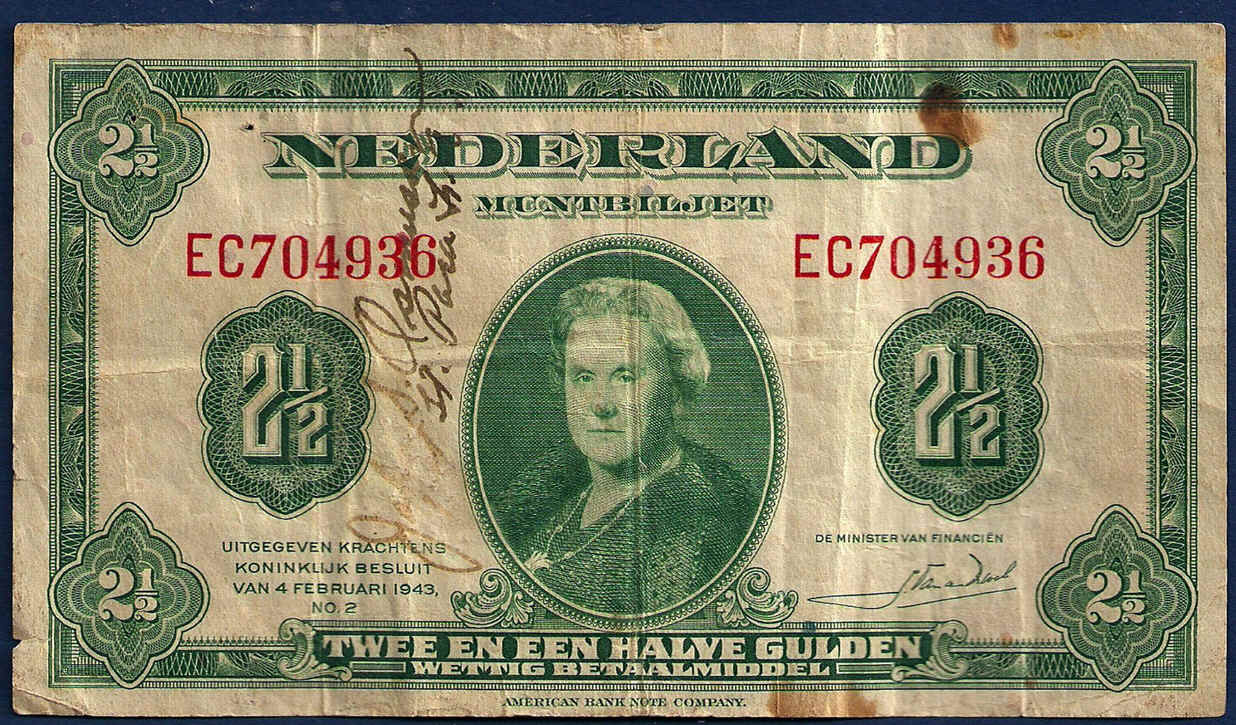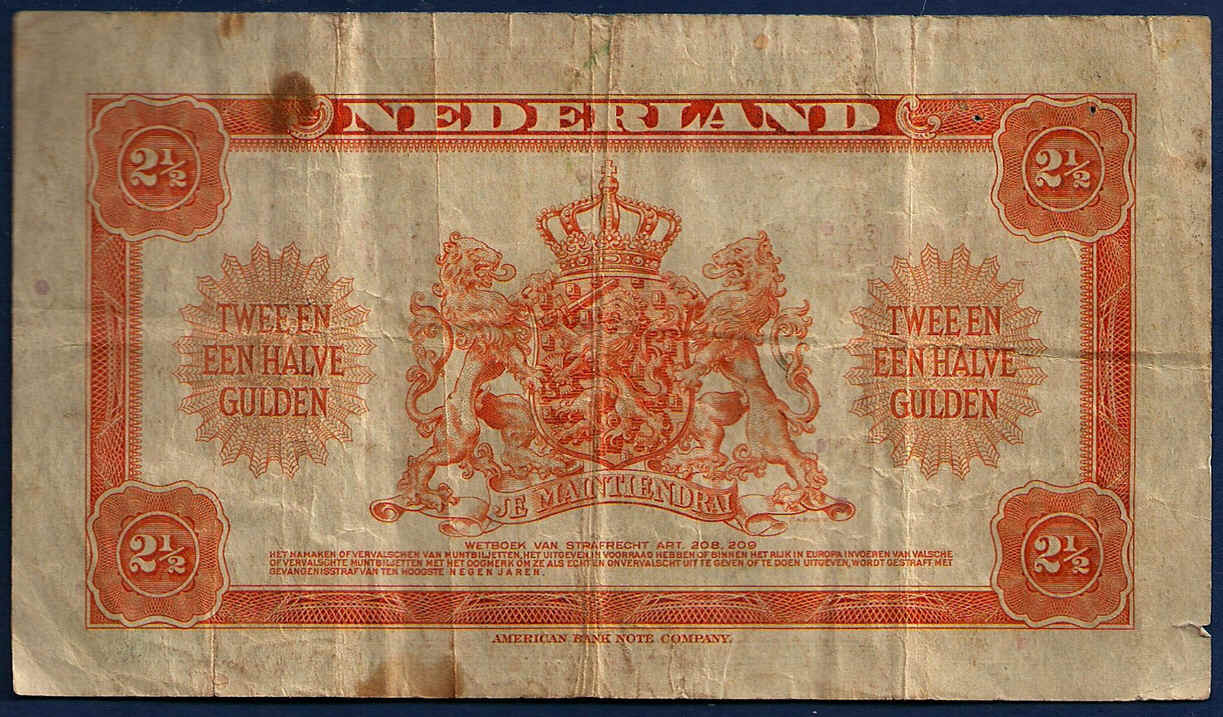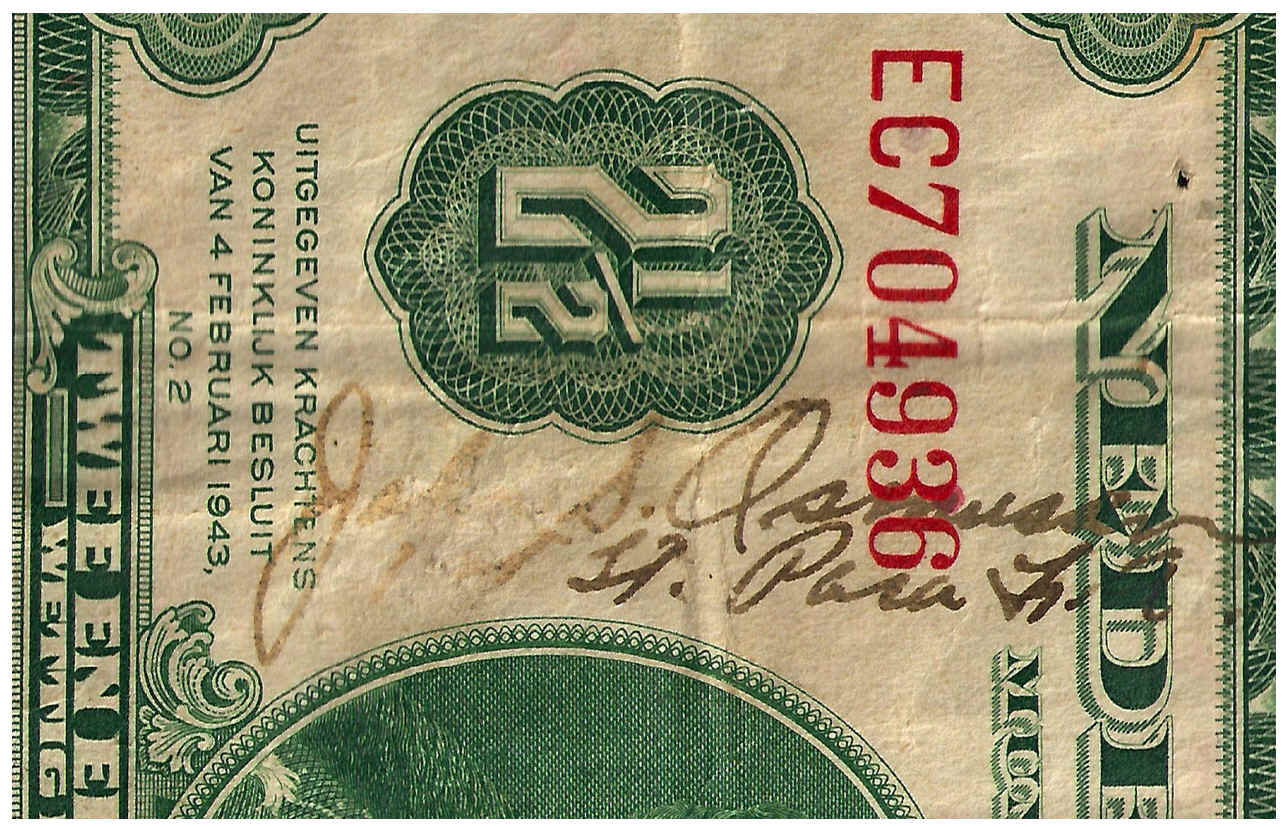



| 127 mm, 72 mm ebay, 15 jul 2013, Uiteindelijke biedprijs: US $24,25 (EUR 17,88), redneckstan |
You are bidding on 1x vintage WW2 Short Snorter Dutch Note from Holland signed by 2nd Lt. (later promoted to 1st Lt.) John S. Osmussen of the 456th Parachute Artillery Battalion, 505th Regiment, 82nd Airborne, who participated in Operation Market Garden (in and around the area of Mook, Holland and Groesbeek, Germany), which was depicted in Cornelius Ryan’s best selling book A Bridge Too Far (later adapted for a major motion picture):
NETHERLANDS / Muntbiljetten (State Notes) – 2-1/2 Gulden [4.2.1943, P-65] Queen Wilhelmina at ctr. Arms at ctr. on back. Printer: American Bank Note Company. The note is circulated, some scattered edge wear, 1x small tear left border near bottom left corner, 2x staple holes upper left field, misc. scattered staining,
SHORT SNORTER SIGNATURE GRAFFITI : John S. Osmussen, 2nd Lt. Para Tpr.” (i.e. paratrooper). OPERATION MARKET GARDEN / SHORT SNORTER ANALYSIS: I have done some research regarding this soldier but there is room for someone else to do much more research concerning this very interesting period in history. Operation Market Garden (17-25 September 1944) was an unsuccessful Allied military operation which was fought in the Netherlands and portions of Germany. At the time it was the largest airborne operation ever attempted. Per the Grave Finder internet sit John S. Osmussen (May 27, 1916 – May 4, 1981) is interned at Fort Snelling National Cemetery, Minneapolis, MN, USA, Memorial # 3485898.
Per the Home of Heroes internet site he was awarded the Silver Star during WW2 and I have to believe it must have been for the valor he displayed during his participation in Operation Market Garden in the area of Mook en Middelaar.
verhalen over de 82e airborne divisie "(18th September 1944). I can remember the long line of gliders at Langer Airfield in England to be loaded. I was loaded in a glider with a jeep and sat in the Jeep. Lt. Osmussen’s seat was next to the pilot in the nose of the glider. This was a routine experience for me as I had started out in the 3 19th GFA Bn. in the states and had many glider flights there where the tow ropes were - tearing before they got the nylon rope. Then in Africa when we moved from Oujda to Kairouan I rode in a glider for about 900 miles that took over six hours. We made that trip in a storm making the trip quite an experience.
Getting back to Holland, we took off and really had a routine flight more or less. When we got over Holland, we saw a glider on the ground with the men getting out of the glider and running. We thought they were trying to avoid capture by the Germans. They were out of sight in a few moments. We didn’t see the C-47 tow-plane that towed it. When we got to the Landing Zone (LZ) the pilot picked out a landing spot on the extreme edge of a field right next to a heavily forested area. It was quite a rough landing in what I guess was a potato field. There were numerous mortar and artillery shells landing in the center of the field, but not near where I was. When we got out of the glider, we had trouble getting the nose up. There was some machine gun fire over our heads so we kinda hugged the ground, but we finally got the nose up and got the jeep out and proceeded to our gun position area.
On our way we were stopped by a trooper from Hqs. He pointed up the hill where the shells were landing where the nose of his glider was up. He said that their trailer loaded with all their communications equipment was in the glider. Lt. Osmussen and the pilot hopped out. Lt. Osmussen sent me and the Hqs. trooper to get his trailer. When we got to the glider two troopers had already removed the trailer from the glider and we broke all records in coupling up and getting out of that area because shells were coming all around. How none of them never hit that glider, I don’t know until this day. After delivering the trailer to Hqs. I returned to pick up Lt. Osmussen. The glider pilot had disappeared. I don’t know where he went. Lt. Osmussen and I drove to the Btry. A gun position.
The following day, September 19, we were sent up to an area called Mook at a railroad bridge. We got up there in the afternoon and dug in. That evening the infantry came along and they dug in and said we had to be prepared for they expected a German attack somewhere out in that area so we spent the night taking turns staying awake in order to keep contact with the infantry if something did happen, but nothing happened that night.
The following morning, September 20, Lt. Osmussen had orders from the infantry to proceed west to the high ground, an area I believe was ealled the Reichswald. I also think it was part of the German Black Forest. We moved to this area and parked the jeep down below and climbed up to the top of this area which was an excellent forward observer position you could see out in front for miles. It was just a super area to have. The infantry came up and dug in. Pvt. Black, the radio operator, discovered that his radio batteries were weak and needed replacing. Lt. Osmussen sent me and Black to get fresh batteries. We got in the jeep and drove to Mook and north to the Btry position. At the Btry, Black got his batteries and I picked up some extra K rations for the FO team.....
I went back to the jeep area and there were quite a few wounded troopers. Lt. Osmussen came up from his forward observer position and he was wounded in the elbow. Black was wounded and I can?t remember how serious he was, but the only one not wounded was Joe Clark. I loaded the jeep up with as many as I could carry and drove them to the Infantry?s Aid Station where all the infantry wounded got out. Again, the infantry sent two troopers out ahead as our scouts. Lt. Osmussen wanted to be taken to the 456th PFA Bn?s. Aid Station. During all this driving I am using my left heel on the clutch pedal, but this trip was easier with all the tires inflated. This is about the end of this event. "
Herman L. Alley story:
September 17, 1944, Sunday Today was D-Day for "Operation Market." The weather was nice. My temperature had subsided. I felt much better, but my sickness left me weak. We watched that morning and the 508th PIR took off and that afternoon watched the returning C-47s. We tried to count the returning aircraft. It seemed that most of them returned, but some were shot up and a few fired distress flares indicating wounded men aboard. We knew that they had taken some flak and knew we could expect the same tomorrow. We learned later that five of their 96 planes were lost. The returning pilots claimed to have put the 508th PIR on their Drop Zone. Hooray for the daylight airborne operations. During the day I inspected all of the battery gliders and found them ready. That afternoon I briefed the officers and troopers on the mission. They knew what was expected of them and were committed to give the mission their best effort. Combat rations, ammunitions and life jackets were issued. All personnel were instructed on the use of the jackets. That evening BCs were briefed on route we would fly and takeoff time. I met my glider pilot 2nd Lt. Ned H. Yarter. He had flown a glider in the Normandy operation and was confident and ready.
September 18, 1944, Monday D+1 today. Headquarters and Battery A are in second glider lift of 80 gliders. The pilot of my C-47 tow plane introduces himself saying, "I want you to know that I will deliver you on your Landing Zone (LZ)." We made a deal and shook hands. I started with communications between the pilot and the glider. The first lift had flown south to an Initial Point (IP) and were over Langer Airfield turning toward Holland when the second lift started taking off at 12:30. The Army Air Corps was short on Glider Pilots, so I was the co-pilot. My glider was number 58 in the lift and contained my command jeep with my driver and our equipment. Shortly after take-off the pilots right rudder control malfunctioned. The glider was flying almost sideways to the C-47. As co-pilot I applied the right rudder to straighten the glider. Lt. Yarter made the decision to release from our C-47. Luckily we had enough altitude to make it back to the airfield with me operating the right rudder pedal. We were immediately surrounded by Military Police. Lt. Yarter had stuck his head down over the controls on his side and said he could fix it. He called out the window to the MPs for a pair of pliers and a coat hanger. Someone came up with the needed items and Lt. Yarter made the necessary repairs. During the interval our C-47 had landed and was standing by. We were soon in the air a second time as our lift was turning over Langer and heading for Holland. In haste to get back in the air our communication line to the plane was not connected. The C-47 pilot did not go to the IP, instead he joined the lift at about 1000 feet altitude and the lift 1000 feet above us all the way to the LZ. We came under antiaircraft fire as soon as we reached the coast, tracers everywhere. From our altitude I could see the Germans manning their weapons on the dikes bordering flooded farmlands. One piece of flak punched a sizable hole in the fuselage of my tow plane. The C-47 pilot kept his word and we landed on the correct LZ at 1615 south of and in sight of Groesbeek. My C-47 pilot banked, wagged his aircraft's wings and headed back through the enemy flak. German heavy artillery was working over the LZ as we landed. The glider landed at 70 mph plowing into a potato field, filling the inside with dirt and potatoes and jamming the clam shell release mechanism. We couldn't get my jeep out. I instructed Lt. Yarter and Pfc. Smith to take the ax off the side of the jeep and chop off the nose of the glider. There were about six Battery A gliders nearby and I joined the assembling men. Lt. Yarter and Pfc. Smith soon arrived, bouncing over the potato rows. As we approached Grosbeek, we passed a group of glider pilots assembled beside the road. Lt. Yarter bailed out and joined them. Along the road I met Capt. Bertram L. O'Neal, Bn. S-2 and received directions to 1st Lt. Aust's location. Upon arriving I found that he had the battery's six 75mm pack howitzers in position. The battery's six guns were not only in position ready to fire, but Btry A troopers had assembled half of our basic load of ammunition and all men were present or accounted for one hour after landing. We suffered only one WIA and three injured on landing. 1st Lt. Aust reported to Bn. Fire Direction Center (FDC) that the battery was laid and ready to fire. We registered on a target in Germany and became the first Battery of 456th PFA Bn. to fire into Germany. (Some will dispute this statement, but this is the way I remember events.) The Battery fired harassing mission on likely enemy targets all night. Our position was only a few yards in rear of the 505th PIR's frontline. It was as if we were part of the front lines.
September 19, 1944, Tuesday I sent 2nd Lt. Osmussen's FO party out to Co. B, 1st Bn., 505th PIR at Heikant. German medium artillery began shelling battery position about 1030. We were well dug in and suffered no damage. About 1115, 20 ME-109s strafed positions nearby for about 10 minutes. One Me-109 kept buzzing around the area. At 1330 I visited Cpl. Howard W. West and Pvt. Louis at Medical Clearing Station. The 504th PIR established contact with us. We received more intermittent counter battery fire (105 and 150mm) from about 1430 until after dark. One 50 cal. machine-gun (MG) was damaged. I and 1st Sgt. Arthur V. Hazlett reconnoitered for a new position that was in the open instead of beneath trees about 600 yards away. A ME-109 spotted us and nosed over to the line up on us. A few yards away was a large haystack. We ran for it and put the haystack between us and the enemy. He peppered the ground on both side of the haystack with a burst of exploding 20mm rounds. He must have figured that he gave us a good scare because he continued nor towards Nijmegen. I requested permission from Bn. FDC to go out of action and move to the open field I had reconnoitered. Permission was granted and the six howitzers and other equipment were moved by 1900. Pvt. William O. McKenna captures a German soldier today. There were many American fighter aircraft overhead during the day. Beginning about 1815 counter battery fire against our position ceased. 2nd Lt. Osmussen's FO Party was cut off and under mortar fire. Pfc. Knueppel and Tec.-5 Cheadle were wounded and Cheadle was evacuated.
September 20, 1944, Wednesday Weather cloudy and hazy all morning. Heard enemy planes, but was unable to see them. An enemy patrol almost entered Battery C's position today. Lt. Ross's FO Party sent out to railroad bridge at Mook.
September 21, 1944, Thursday Weather was foggy during the morning and clear in the afternoon. Two German soldiers were taken prisoner by 1st Sgt. Hazlett and Pfc. Cook this morning. Again Lt. Osmusen's FO Party came under heavy mortar fire at 1400. He was wounded as was Pfc. Black. Cpl. Fitch A. Rowley was killed. The 505th PIR company also had casualties and was forced to withdraw. All wounded were evacuated to a field hospital in Nijmegen. The dead troopers bodies were not recovered until September 1945. I recommended Lt. Ossmussen for a well deserved battlefield promotion to 1st Lt.
September 22, 1944, Friday Weather was foggy in the morning and clear in the afternoon. The 3rd Bn., 505th PIR pushed east about 1000 yards and took Hagst. I with Lt. Ross and S/Sgt Prosser established an OP in a Glider on high ground 800 yards to the right front of battery position. We had an excellent view of Germany, but saw little activity. I adjusted fire on two probably targets. At 1600 fired on a small German patrol to the south that disappeared quickly and 1900, a German MG firing to the southeast. I adjusted a British medium artillery unit (8 guns) with good effect on this target. A lot of British and German planes were observed. A heavy firefight occurred about 1000 yards south of our position. A lot on anti-aircraft flak from 1700 to 1900. There was heavy shelling into a nearby area all night. Big firefight in 3rd Bn., 505th PIR area near Horst. Lt. Ross's FO Party returned to position. One of my machine guns opened fire on two man German patrol in potato field.